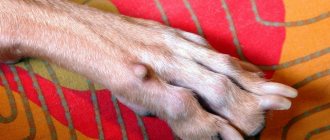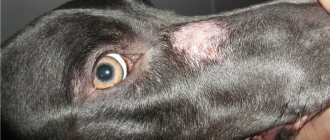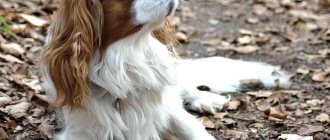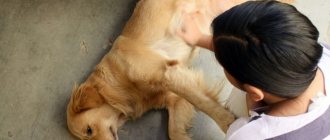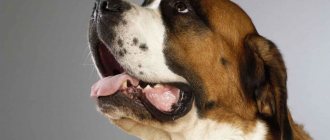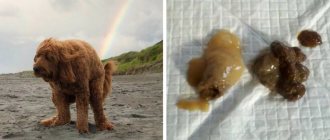Often, while stroking the dog, the owner discovers a lump on its body and immediately begins to panic, suspecting that the pet has a dangerous disease. Of course, fears may not be groundless.
It is likely that the lump under the skin has a cancerous etiology, but you should not sound the alarm without showing the animal to the veterinarian, because neoplasms may be harmless and may not even require treatment.
Causes of the disease
Lumps under the skin in different parts of the body can have different origins - a bee sting, a malignant or benign neoplasm, an abscess, etc. Some swellings go away after a couple of days, others increase in size over time and begin to cause serious discomfort to the pet.
The main reasons for the appearance of bumps on a dog’s body are:
- injury;
- viral infection;
- damage to blood vessels after surgery;
- oncology;
- penetration of bacteria.
If the subcutaneous lump does not go away after two days and bothers the animal, contact a veterinary clinic.
Where to go? Which clinic will help?
Moscow
- State Vet . One of the Moscow clinics with an impeccable reputation. An examination by a specialist is only 400 rubles. There is a 50% discount during happy hours, 15% for inviting a friend, call for details. Address: metro station Bratislavskaya, Bratislavskaya street, 22.
- Vetlife . Clinic with modern veterinary equipment. A veterinary pharmacy and a grooming salon are also at your service. Initial appointment is 600 rubles. Address: Beskudnikovsky Boulevard, 12.
- Vega . The Vega network of veterinary clinics began its existence in St. Petersburg. A branch has recently been opened in Moscow. There is a 40% discount on medical examinations for older cats and dogs. Initial appointment is 765 rubles, appointment with a dermatologist is 1500 rubles. Address: Marshal Katukova Street, 17k1, 2nd floor.
Saint Petersburg
- Chelsea . Veterinary clinic with excellent reviews. Animal owners note the high professionalism of veterinarians and groomers, and the responsiveness of administrators. The clinic offers a 10% discount on services on Tuesdays and Fridays. Specialists carry out home visits, cost from 1000 rubles. Address: Budapestskaya street, 36k2, ground floor.
- Vetmir . Modern clinic with good equipment. The reviews note that the clinic’s doctors are not only highly qualified specialists, but also good psychologists. They easily find contact with animals, explain in detail the tactics of action and prognoses for further treatment. Admission costs from 500 rubles. Address: Komendantsky Prospekt, 51 k1, ground floor.
- Clinic Bars . The initial appointment is only 290 rubles. Wide range of veterinary procedures. The staff is very friendly and takes their work responsibly. Address: Alexandra Matrosova street, 9, 1st floor.
Krasnodar
- Help paw . The clinic has modern equipment and conducts laboratory tests. There is a hospital and a pet hotel. The owners praise the staff for their simple human attitude, responsiveness and quality work done. Initial appointment is 300 rubles. Address: Architect Ishunin Street, 7/1 bldg.
- Nika Clinic . The extensive experience of our specialists allows us to quickly and accurately carry out only the necessary research. You can call a veterinarian at home. Stavropolskaya, 107/10, ground floor.
- Veterinary site . The clinic carries out laboratory tests. It has its own pharmacy, which is very convenient for owners leaving the reception. Address: Zavodovskogo, 23, ground floor; entrance from the street Komarova.
- Clinic "Na Babushkina" . Has been carrying out its work for more than 20 years. The clinic’s veterinarians are guided by the principles of evidence-based medicine. Address: Babushkina street, 160.
Quantity
Main symptoms
There is no single clinical picture for bumps on a dog’s body, since they can be caused by different diseases, each of which has its own characteristic signs.
So, with an abscess that occurs under the influence of a bacterial infection that enters the body through a bite, puncture wound or scratch, the dog experiences swelling, fever, and pain. The lump swells for several days, after which it begins to fester.
Smooth-haired dogs often develop papillomas and warts on their bodies. The cause of their occurrence is considered to be a viral infection. The growths on the skin are usually brown in color and are painless, but it is still worth consulting a veterinarian.
The dog may develop a hematoma as a result of bruises or fluid accumulation when blood vessels are damaged during surgery. It is a formation that changes the shape of the part of the body where it is located. It does not cause discomfort to the dog, however, if the hematoma does not go away for a long time, consultation with a specialist will also be required.
A cyst can appear anywhere: both on the body and on the dog’s face, for example, at the junction of the jaws. Upon inspection, it is quite easy to detect. It appears as reddish, painful abscesses that the dog tries to lick.
Pyoderma is a purulent inflammation of the skin in dogs, which is accompanied by a rash and papules. Swellings can form all over the body, paws, in folds of skin, and on the face.
Insect bites (bees, ticks and even mosquitoes) can cause painful swelling. The most dangerous bites are to the face and mouth.
There are two types of tumors in dogs: benign and malignant. Benign tumors grow slowly and, as a rule, do not cause discomfort to the dog. Unlike malignant tumors, they do not metastasize. However, this does not mean that they do not pose a danger to the health of the animal, since over time they can degenerate into cancer.
Malignant tumors appear as a result of cell mutation. Cancerous tumors are characterized by rapid growth, absence of symptoms at the initial stage, and metastases. Sometimes the bumps break through the skin and bleed. As the disease progresses, an increase in symptoms is observed.
Stages
Staging is a determination of where the cancer is located, whether and where it has spread, and its effect on other parts of the body.
Doctors use diagnostic tests to determine the stage of cancer; they may need information based on tissue samples obtained at surgery, so staging may continue until all tests are completed. Information about the stage helps the doctor determine which treatment is optimal and predict the possibility of recovery.
TNM tumor classification system
One way to determine the stage of cancer is the TNM system. Doctors use the results of diagnostic tests and scans to answer questions such as:
- Tumor (T): its size and location?
- Lymph nodes (N): extent of spread of the process to the lymph nodes?
- Metastasis (M): Has the cancer spread to other parts of the body?
The results are combined to determine each patient's cancer stage. Stage provides a common way to describe cancer so doctors can work together to plan the best treatment.
Diagnostics in a veterinary clinic
To make a correct diagnosis of a dog, a veterinarian will need to examine the animal and do a number of necessary diagnostic tests, including:
- general and biochemical blood tests;
- Analysis of urine;
- Ultrasound;
- biopsy for histological examination of tissue;
- fingerprint smear - to determine cell atypia or the presence of an infectious agent;
- computed tomography - if a malignant tumor is suspected;
- radiography - to determine the depth of penetration of the lump into the soft tissue.
According to indications, additional diagnostic methods can be used to obtain more complete information.
What to do if you discover a problem?
If you find a lump on an animal’s head, then first of all you need to carefully examine and feel it. If the formation is painful for the animal, it is recommended to urgently show it to a doctor.
If the lump causes serious concern to the animal or other formations begin to appear over time, the veterinarian must first figure out what the cause of its occurrence is. In this case, one cannot do without an extensive list of studies, among which it is necessary to highlight:
- Radiography;
- Biopsy;
- Computed tomography;
- Taking a swab-imprint.
If the lump does not cause pain to the animal, does not secrete pus or change its color, the dog owner should observe the lump for many days. It is likely that such swelling will go away on its own. At the same time, you need to remember that you need to prohibit the animal from licking the area in the area of inflammation, as this may cause the occurrence of granuloma. If the formation begins to change, it is necessary to urgently show the dog to a doctor.
Treatment method and prognosis
After making a diagnosis, the doctor develops a treatment regimen. For each individual case, it will be individual depending on the disease, the severity of the animal’s condition, age, and tolerance (intolerance) to medications.
For cancerous tumors, drug treatment is not effective, since no drug can stop the development of the tumor. Radiation therapy, chemotherapy, and surgery to remove the tumor are indicated. After surgery, the course of chemoradiotherapy is repeated.
Benign tumors are removed surgically.
Treatment of abscess is also surgical. The inflamed area is opened, the open wound is washed, and Levomekol ointment is injected through the installed drainages.
The prognosis depends on the diagnosis. In most cases it is favorable, with the exception of malignant tumors. Cancer responds well to treatment if you contact a specialist in the initial stages of the disease. So, at stages 0, I, cancer is curable by 90%, at stages III, IV - by 50%.
Opening an abscess on the gum
The abscess is always opened. This reduces the risk of spontaneous opening, which can cause complications. The flux is opened under local anesthesia. If the patient has panic or other indications, the doctor may choose a different method of anesthesia.
A small incision is made on the anesthetized gum in the area of the gumboil, no more than 2 cm in length. After the dissection, the doctor completely cleans and sterilizes the purulent cavity and treats it with antiseptics. A crust should not be allowed to form in the area of the incision, as it will interfere with the outflow of ichor and purulent contents. To do this, a drainage is inserted into the incision. After the cavity is cleared of pus, you can begin general treatment, the purpose of which is to eliminate the causes that caused periostitis.
Prevention
It is best to take care of your dog’s condition in advance and take preventative measures that will help avoid inflammation of the lymph nodes. The most important thing is to treat infectious diseases in a timely manner, since in most cases they provoke the development of lymphadenitis in the animal. Do not self-medicate, seek help from experienced and qualified veterinarians.
Other preventive measures that will help avoid inflammation of the dog’s lymph nodes:
- Never neglect allergic manifestations . It is best to quickly detect the allergen and eliminate it from your pet’s life;
- Take steps to strengthen your dog's immune system. The stronger it is, the more reliably it resists any viruses, parasites and fungi;
- Stick to a balanced diet. Choose food that is suitable for your dog's breed and age.
Remember that your pet needs your attention and care. Unfortunately, he will not be able to say what is bothering him, so it is necessary to be attentive to the health of the animals. Do not neglect regular preventive examinations at the veterinarian and seek qualified help in a timely manner.
Health to you and your pet!
Lumps of malignant origin
In long-haired dogs or pets with dense, elastic, thick hair, new growths (bumps) on the skin are not always noticeable at the very beginning of their appearance. Therefore, when combing, bathing or simply stroking, you need to examine the surface of the skin on the neck and notice the slightest irregularities.
Lumps of malignant origin (sarcomas, fibrosarcomas) are especially dangerous; they are changed cells of the dermis, multiplying chaotically and rapidly. Due to this, the cones grow quickly and increase in volume.
Dog breeds most susceptible to skin cancer:
- Golden Retrievers.
- Boxers.
- Terriers.
- Great Danes.
The main symptom that indicates the malignant nature of the bumps on the skin is an uneven, ulcerated surface. With metastasis and damage to internal organs, new clinical signs are added, characteristic of changes occurring in the body. General symptoms: inactivity, apathy, refusal to feed, weight loss, etc.
When a lump degenerates, as a rule, it is stage 4, its configuration changes, areas of bleeding and suppuration appear.
Can complications arise?
If you promptly seek help from a veterinarian and treat your dog in accordance with his instructions, you will be able to avoid complications that arise from inflammation of the lymph nodes in animals. If this is not done, the functioning of the entire lymphatic system will be impaired, which means that the pet will lose the natural barrier that protects it from infections.
With nonspecific lymphadenitis, the following complications are possible:
- phlegmon,
- abscess,
- thrombophlebitis,
- sepsis,
- lymphostasis, etc.
The prognosis in the absence of treatment is death.
Internal tumors
Some dogs develop internal masses in the chest or abdomen, especially older dogs. Internal masses may be discovered because of the symptoms they cause (such as difficulty breathing or vomiting) or during a routine medical examination.
Internal lesions can be benign or malignant and are usually definitively diagnosed through a combination of x-rays, ultrasound, laboratory tests, and biopsy. Treatment depends on the location and type of tumor.
